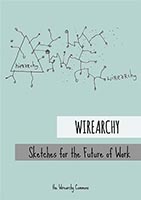
In The Social Psychology of Organizing, Karl Weick exposed the theory of enactment, stating that organizations were fundamentally an abstraction of the reality, essentially brought to life through management’s narrative. In that sense, changing the way we work requires much more than technology and the empowerment of knowledge workers. Taking a broader perspective, and looking at organizations, not only as a production and profit-making machines, but as center of a part of human activities mainly taking place in cities, sheds a different light on the role and nature of what we call social businesses.
While trade was an important part of the wealth of cities during Antiquity, we had to wait until the XIth century for economic exchanges to regain importance after few centuries of Barbaric invasions and feudal wars. At that time, cities began to define themselves through their economic activities, and to specialize their production. Physically, as well as symbolically, delimited by heavy walls, the medieval city grew organically, around a center dominated by religious buildings, and commercial activities cohabited with residential houses at the heart of mostly undifferentiated territories. Furthermore, despite its strong geographical delimitation, the medieval city was interdependent with its surroundings. Rural territories provided the necessary food, were the place to build roads to link cities, and were inhabited by the most important part of the population (85% in France).
During the Renaissance, cities undertook a crucial transformation. Letting them grow anarchically was no more an option, and new cities began to take shape, planned and designed according to the notions of harmony, symmetry and simplicity rediscovered from Antiquity. At the same time, and during the following centuries, specialization was taken to another level, as cities were specially built to accommodate and support one of the three main powers of this era: economical, political and administrative, and military. Everywhere across Europe, royal cities competed in refinement, while engineers like Vauban in France or van Coehoorn in the Netherlands conceived and built fortified towns according to the principles of military architecture applied to urbanism. The economic role of cities was at that time preponderant, and more than a few had their name directly associated with a production or transformation activity. Think for example about Antwerp’s diamond commerce or Calais’s lace manufacturing.
Work and the city: the historical divorce
With the XIXth century’s industrial revolution took place a rapid and radical disruption: at that time, firms took over cities as symbols as well as guarantors of the whole economic activity. Work began to be dissociated from other social activities. The city, from holistic center of human activities, has progressively seen its role and influence diminish over time. As companies were gradually loosing contact with the other aspects of human life, some attempts were made to provide workers with a unified environment, this time not under the responsibility of city’s governance, but the one of modern “captains of industry”. Taking inspiration from Charles Fourier’s utopian theory of phalanxes, between 1856 and 1858, Jean-Baptiste Godin built the Familistère in Guise, Belgium, to provide workers with all the necessary infrastructure and services he supposed they needed to be productive at work. At the beginning of the XXth century, Edouard Michelin has built whole new districts in Clermont-Ferrand, allotting them schools, sports facilities, and even a church.
But such initiatives remained the exception. Most of the time, the city abdicated and the divorce with work was pronounced, leading to deep transformations. In Europe, under the influence of US cities, new districts discarded the old organic design to adopt a grid-like arrangement. Streets were drawn to favorite circulation over communication. The modern city was functional and efficient, according to The Athens Charter, the urban planning guidelines written by Le Corbusier and published in 1943. By losing its role as entity of production, the city had lost its connections to other cities, resulting in a fragmentation of local territories, and in an overall competition, as Richard Florida recently explained. Competition in which they are mainly spectators, as being orchestrated by external economical powers,. Overall, it lost most of its soul. In 1961, Lewis Mumford stated:
“A universal suburb is almost as much of a nightmare, humanly speaking, as a universal megalopolis: yet it is toward this proliferating nonentity that our present random or misdirected urban growth has been steadily tending. A large scale pattern of expressways and airfields and sprawling car parks and golf-courses envelops a small scale, increasingly shrunken mode of life.”
From customer-centricity to citizen-centricity
Drawing a parallel between the evolution of the city and the one of the workplace is of course tempting. The industrial era has rationalized space, productivity has got rid of shapeless shops and offices to implement neat open spaces, large passageways and functional lines of production. I might push the analogy even further: a majority of companies still operate in a Modernist-like manner: managers are the workplace equivalent of continuous commuters (the dark side of mobility), and knowledge workers populate impersonal open spaces or tentacular alignments of cubicles… But there is much more to be understood in the evolution of cities and of their relationships with economical actors.
The failure of Modernism, which gave birth to endless low-rise housing suburbs as well as dehumanized minimalist districts, nurtured alternative ways to rethink the city. Starting in the middle of the seventies, the post-modernist movement rejected the utilitarian view of post-war urbanists, aiming at integrating new constructions into the context of the city, and at reconciling the main human activities within the same space. Cities are complex systems, in which many networks and symbolic structures superpose or interweave, and the search for new harmony pursued by many urbanists and policy makers is a still to be solved wicked problem. But the movement has started…
Inside organizations, the frontier separating private from professional life is rotting, and “work” is no more a monolithic activity separated from others. Increased mobility and remote working, allowed by technology, are gaining in importance, and are quietly involving new relationships to time and to space. For how long will we afford to keep on dealing with urban landscapes and with the “socialization” of business as two separate perspectives?
As John Hagel and John Seely Brown write, the workplace needs radical redesign to allow for more collaboration and continuous learning. Customer-centricity, whatever this really means, not only implies the growth of different behaviors, but also to think differently about our spatial and symbolic relationships to customers. Providing them with more channels to interact is not enough, we need to design them in a more human way, and allow customers to embed these channels in their way of life. Cities, and those who think and design them, are ahead of organizations in tackling these problems.
Furthermore, the divorce between work and other facets of human life which took place during the industrial era has to be considered under the light of Enterprise 2.0. As organizations aim at leveraging the relationships dynamics, they must taking seriously into account their own role in the city, which encompasses most of these dynamics. Redesigning work means rethinking the place of work inside human activities, thus inside cities. Restoring the city’s economical role and identity has become a sine qua non condition to a successful urbanism as well as a truly social business. Organizations do not need to become customer-centric, but citizen-centric. Utopia? Have a look at Zappos’ Downtown Project, which goal is to restore a continuity between the workplace and the urban community. The future of Social Business lies at the heart of the city.





